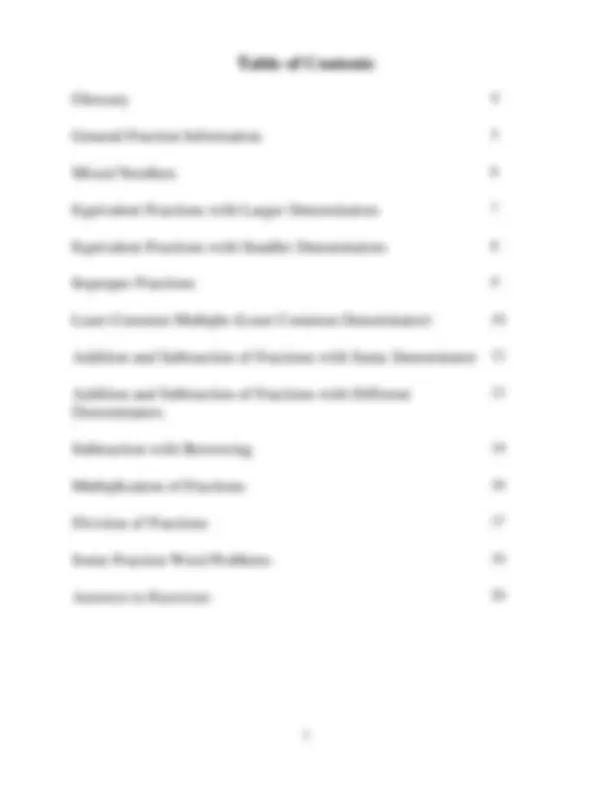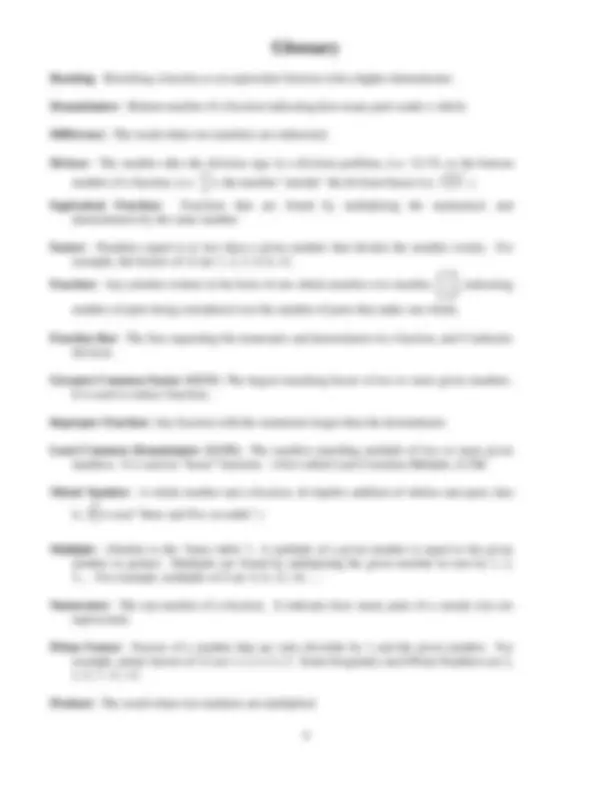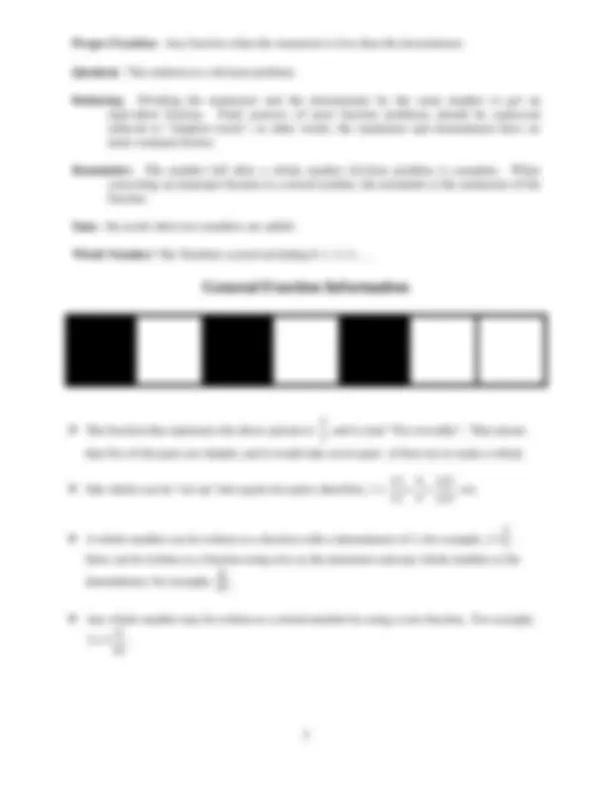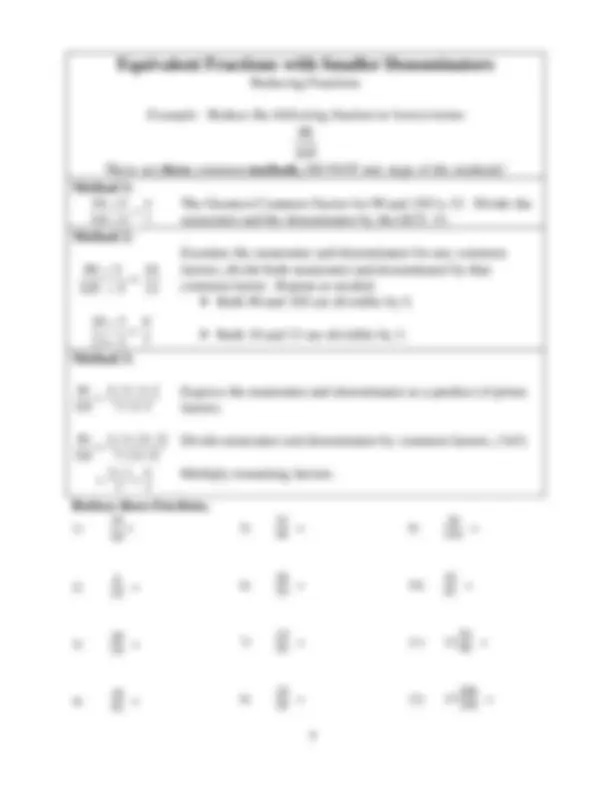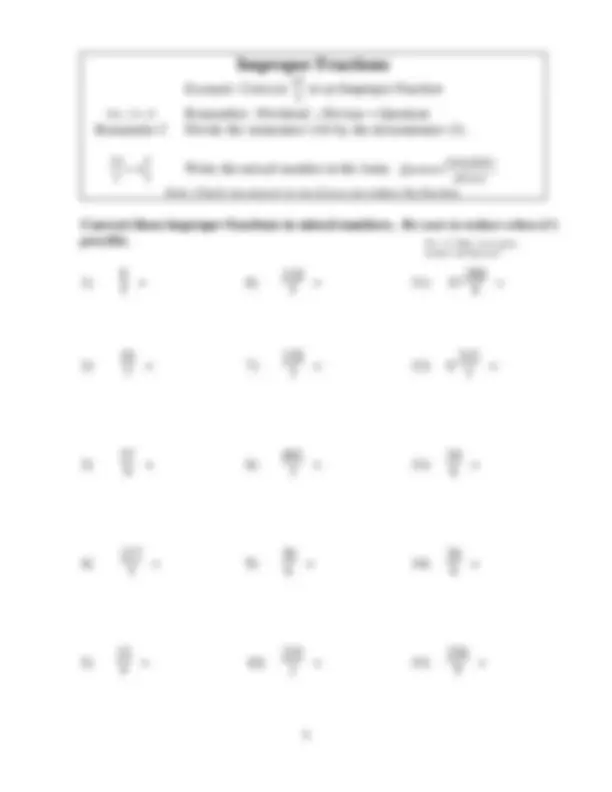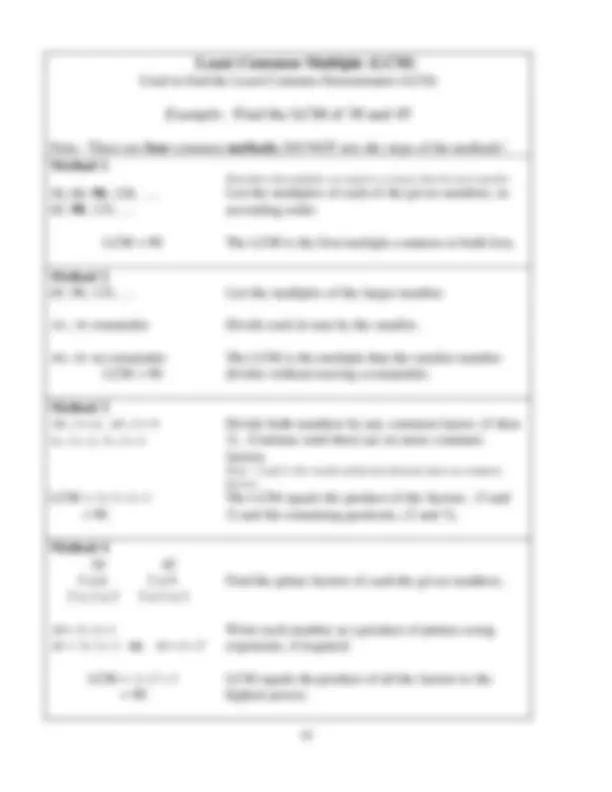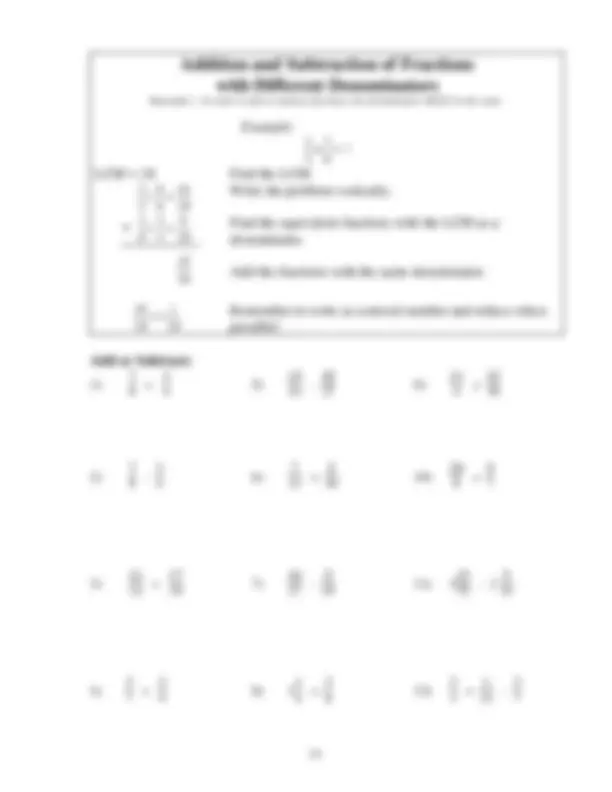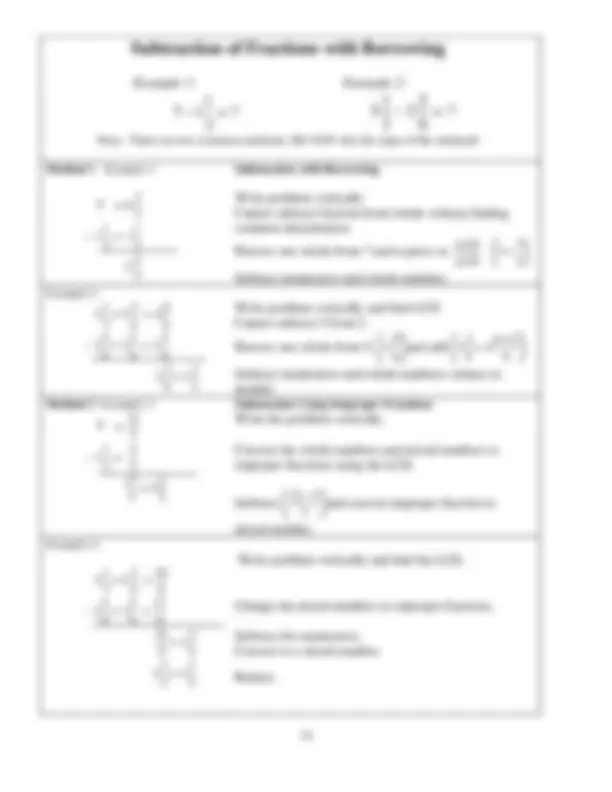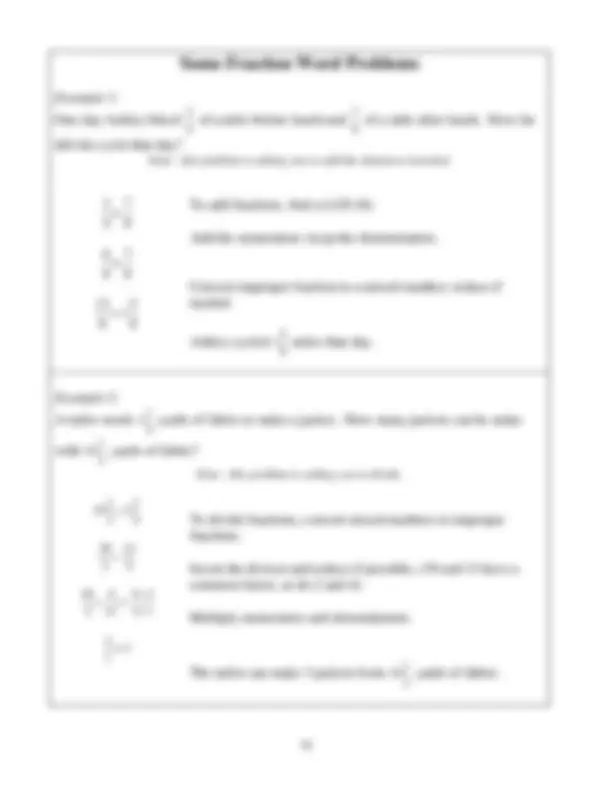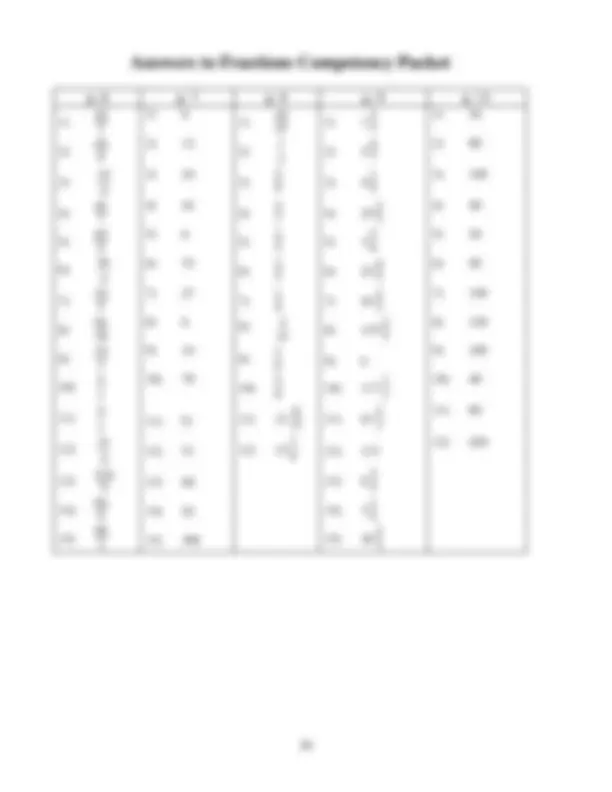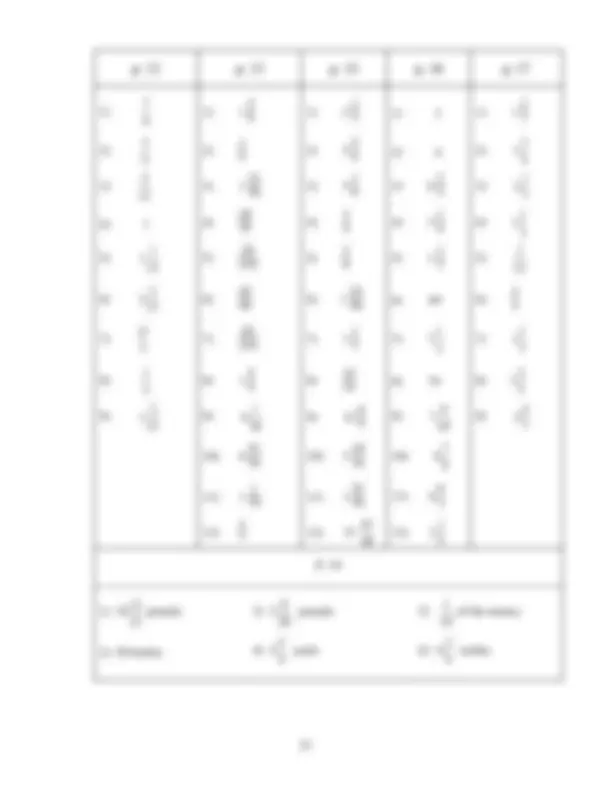Download Fraction Competency Packet and more Study notes Algebra in PDF only on Docsity!
Fraction
Competency
Packet
Developed by: Nancy Tufo
Revised 2004: Sharyn Sweeney
Student Support Center
North Shore Community College
To use this booklet, review the glossary, study the examples, then
work through the exercises. The answers are at the end of the
booklet. When you find an unfamiliar word, check the glossary for
a definition or explanation.
Calculators are not allowed when taking the Computerized
Placement Test (CPT), nor in Fundamentals of Mathematics, Pre-
Algebra, and Elementary Algebra; therefore, do not rely on a
calculator when working the problems in this booklet.
If you have difficulty understanding any of the concepts, come to
one of the Tutoring Centers located on the Lynn, Danvers Main
and Danvers Hathorne Campuses. Hours are available at (978)
762-4000 x 5410. Additional Tutoring Center information can be
found on the NSCC website at
www.northshore.edu/services/tutoring. The Centers are closed
when school is not in session, and Summer hours are limited.
Glossary
Boosting : Rewriting a fraction as an equivalent fraction with a higher denominator.
Denominator: Bottom number of a fraction indicating how many parts make a whole.
Difference: The result when two numbers are subtracted.
Divisor: The number after the division sign in a division problem, (i.e. 12÷ 7 ); or the bottom
number of a fraction, (i.e. 7
(^12) ); the number "outside" the division house (i.e. 7 12 ).
Equivalent Fraction: Fractions that are found by multiplying the numerators and denominators by the same number.
Factor: Numbers equal to or less than a given number that divides the number evenly. For example, the factors of 12 are 1, 2, 3, 4, 6, 12.
Fraction: Any number written in the form of one whole number over another, (^) ⎟ ⎠
, indicating
number of parts being considered over the number of parts that make one whole.
Fraction Bar: The line separating the numerator and denominator in a fraction, and it indicates division.
Greatest Common Factor (GCF): The largest matching factor of two or more given numbers. It is used to reduce fractions.
Improper Fraction: Any fraction with the numerator larger than the denominator.
Least Common Denominator (LCD): The smallest matching multiple of two or more given numbers. It is used to "boost" fractions. (Also called Least Common Multiple, LCM)
Mixed Number: A whole number and a fraction. (It implies addition of wholes and parts; that
is, 3
7 is read "three and five sevenths".)
Multiple: (Similar to the "times table.") A multiple of a given number is equal to the given number or greater. Multiples are found by multiplying the given number in turn by 1, 2, 3,... For example, multiples of 4 are 4, 8, 12, 16, …
Numerator: The top number of a fraction. It indicates how many parts of a certain size are represented.
Prime Factor: Factors of a number that are only divisible by 1 and the given number. For example, prime factors of 12 are 1 x 2 x 2 x 3. Some frequently used Prime Numbers are 2, 3, 5, 7, 11, 13.
Product: The result when two numbers are multiplied.
Proper Fraction: Any fraction when the numerator is less than the denominator.
Quotient: The solution to a division problem.
Reducing: Dividing the numerator and the denominator by the same number to get an equivalent fraction. Final answers of most fraction problems should be expressed reduced to “simplest terms”; in other words, the numerator and denominator have no more common factors.
Remainder: The number left after a whole number division problem is complete. When converting an improper fraction to a mixed number, the remainder is the numerator of the fraction.
Sum: the result when two numbers are added.
Whole Number: The Numbers system including 0, 1, 2, 3,….
General Fraction Information
¾ The fraction that represents the above picture is 7
and is read “five sevenths”. That means
that five of the parts are shaded, and it would take seven parts of that size to make a whole.
¾ One whole can be "cut up" into equal size parts; therefore, 1 = 123
= = , etc.
¾ A whole number can be written as a fraction with a denominator of 1; for example, 2 =
Zero can be written as a fraction using zero as the numerator and any whole number as the
denominator, for example,
¾ Any whole number may be written as a mixed number by using a zero fraction. For example,
Finding Equivalent Fractions with Larger Denominators
This process is sometimes called “ Boosting ”
56
?
8
5 Example : =
56 ÷ 8 = 7 Divide the larger denominator by the smaller to find the factor
used to multiply the denominator. (Note: The product of the
smaller denominator and the factor is the larger denominator)
×
×
× =
Use this factor to multiply the numerator.
The result is two equivalent fractions.
Note: Equal denominators are required for addition and subtraction of fractions.
Find the equivalent fractions as indicated:
100 =^700
3 =^462
Equivalent Fractions with Smaller Denominators
Reducing Fractions
Example: Reduce the following fraction to lowest terms
105
90
There are three common methods, DO NOT mix steps of the methods!
Method 1:
÷
÷ The Greatest Common Factor for 90 and 105 is 15. Divide the
numerator and the denominator by the GCF, 15.
Method 2:
÷
÷
÷
÷
Examine the numerator and denominator for any common
factors, divide both numerator and denominator by that
common factor. Repeat as needed.
¾ Both 90 and 105 are divisible by 5.
¾ Both 18 and 21 are divisible by 3.
Method 3:
× ×
× × ×
= Express the numerator and denominator as a product of prime
factors.
× ×
× × ×
= Divide numerator and denominator by common factors, (3x5)
×
= Multiply remaining factors.
Reduce these fractions.
Least Common Multiple (LCM)
Used to find the Least Common Denominator (LCD)
Example: Find the LCM of 30 and 45
Note: There are four common methods ; DO NOT mix the steps of the methods!
Method 1
Remember that multiples are equal to or larger than the given number.
List the multiples of each of the given numbers, in
ascending order.
LCM = 90 The LCM is the first multiple common to both lists.
Method 2
45 ÷ 30 remainder
90 ÷ 30 no remainder
LCM = 90
List the multiples of the larger number.
Divide each in turn by the smaller.
The LCM is the multiple that the smaller number
divides without leaving a remainder.
Method 3
30 ÷ 5 = 6 ; 45 ÷ 5 = 9
6 ÷ 3 = 2 ; 9 ÷ 3 = 3
Divide both numbers by any common factor, (5 then
3). Continue until there are no more common
factors.
Note: 2 and 3, the results of the last division have no common factors.
LCM = 5 × 3 × 2 × 3
The LCM equals the product of the factors, (5 and
3) and the remaining quotients, (2 and 3).
Method 4
5 x 6 5 x 9
5 x 2 x 3 5 x 3 x 3
30 = 5 × 2 × 3
45 = 5 × 3 × 3 Or 45 = 5 × 32
LCM = 2 × 32 × 5
Find the prime factors of each the given numbers.
Write each number as a product of primes using
exponents, if required.
LCM equals the product of all the factors to the
highest power.
In each exercise, find the LCM of the given numbers.
- Glossary
- General Fraction Information
- Mixed Numbers
- Equivalent Fractions with Larger Denominators
- Equivalent Fractions with Smaller Denominators
- Improper Fractions
- Least Common Multiple (Least Common Denominator)
- Addition and Subtraction of Fractions with Same Denominator
- Subtraction with Borrowing
- Multiplication of Fractions
- Division of Fractions
- Some Fraction Word Problems
- Answers to Exercises
- 4 and
- 16 and
- 20 and
- 5 and
- 12 and
- 12 and
- 50 and
- 24 and
- 36 and
- 8 and
- 16 and
- 28, 35, and
Addition and Subtraction of Fractions
with Different Denominators
Remember: In order to add or subtract fractions, the denominators MUST be the same.
Example:
LCM = 24 Find the LCM
× =
× =
Write the problem vertically.
Find the equivalent fractions with the LCM as a
denominator.
Add the fractions with the same denominator.
= Remember to write as a mixed number and reduce when
possible!
Add or Subtract:
12 +^
12 +^
27 -^
Subtraction of Fractions with Borrowing
Example 1: Example 2:
7 − 1 =? 6
5 2 3
1 5 − =
Note: There are two common methods; DO NOT mix the steps of the methods!
Method 1 Example 1
Subtraction with Borrowing
Write problem vertically
Cannot subtract fraction from whole without finding
common denominator.
Borrow one whole from 7 and express as.
LCD
LCD
Subtract numerators and whole numbers.
Example 2
Write problem vertically and find LCD
Cannot subtract 5 from 2.
Borrow one whole from 5, ⎟
4 and add ⎟
Subtract numerators and whole numbers; reduce as
needed.
Method 2 Example 1:
7 = 3
Subtraction Using Improper Fractions
Write the problem vertically.
Convert the whole numbers and mixed numbers to
improper fractions using the LCD.
Subtract ⎟
and convert improper fraction to
mixed number.
Example 2:
Write problem vertically and find the LCD.
Change the mixed numbers to improper fractions.
Subtract the numerators.
Convert to a mixed number.
Reduce.
Multiplication of Fractions
Example:
×
Note: LCD is not needed to multiply fractions.
× +
Change mixed numbers to improper fractions
×
×
× =
Before multiplying, reduce by dividing any numerator
with any denominator with a common factor. (3 and 6
have a common factor of 3)
×
×
Multiply numerators and denominators
= Convert improper fractions to mixed numbers.
Multiply:
4 ×
3 ×
6 × 1
2 ×
×
4 ×
3 ×
34 × 2
9 ×
7 ×
18 × 1 ×
3 × ×
Division of Fractions
Example:
8
3 2 4
3
2 ÷ OR
Note: One fraction divided by another may be expressed in either way shown above. Also, LCD is not needed to divide fractions.
2 = and
2 = Convert mixed numbers to improper fractions
19
8 4
11 8
19 4
11 ÷ = ×
Invert the divisor ⎟
. (Turn the fraction after the
division sign upside down)
1 19
11 2 4 19
11 8 ×
×
×
× (^) Reduce if possible. (4 and 8 have a common factor)
19
22 1 19
11 2
×
×
Multiply numerators and denominators
19
3 1 19
22 = Convert to a mixed number and reduce if needed.
Divide these fractions. Reduce to lowest terms!
÷
- ÷^ = 7
3
4
3
3) 3 ÷ 1
2 ÷ 6 =
4 ÷ 3 =
÷ 2
÷ 1
Solve the following problems.
1. An empty box weighs
2 pounds. It is then filled with
16 pounds of fruit. What is
the weight of the box when it is full?
2. Yanni is making formula for the baby. Each bottle contains
6 scoops of formula.
The formula container holds 320 scoops of formula. How many bottles of formula
can Yanni make?
3. Miguel bought
2 pounds of hamburger,
1 pounds of sliced turkey, and 2 pounds
of cheese. What was the total weight of all of his purchases?
4. Sheila had 8 yards of fabric. She used
2 yards to make a dress. How much fabric
does she have left?
5. A father leaves his money to his four children. The first received
, the second
received
, and the third received
. How much did the remaining child receive?
(Hint: You can think of father’s money as one whole.)
6. Find the total perimeter (sum of the sides) of an equilateral triangle, (triangle with
equal sides), if each side measures
2 inches.
Answers to Fractions Competency Packet
p. 6 p. 7 p. 8 p. 9 p. 11
25 1)^1
9 3)^4
7 4)^25
3 5)^3
3 6)^22
4 7)^42
14
9
- 133
6 9)^6
8 10)^70
6 10)^117
11) 72 11)^12
11 11)^61
12) 51 12)^15
8 12)^113
9 13)^60 13)^6
8 14)^42 14)^3
3 15)^308 15)^28

